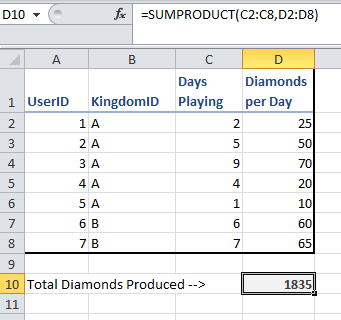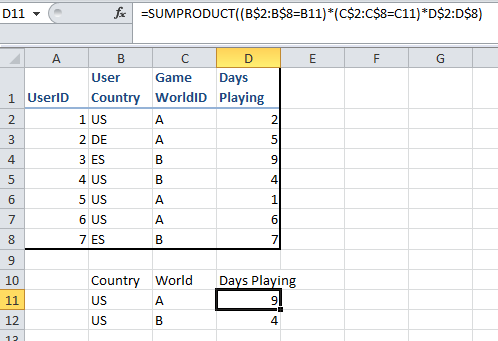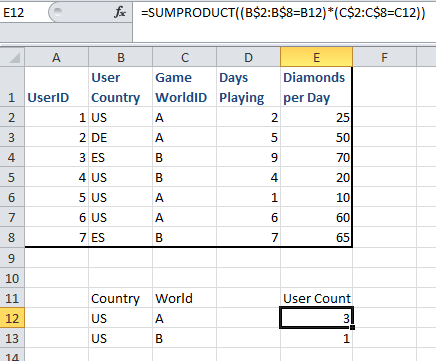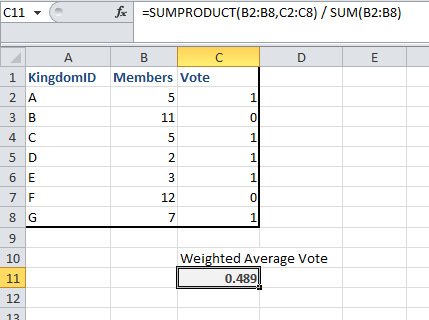SUMPRODUCT is a very useful and flexible function in Excel, but it also has one of the trickier syntaxes to get right. I use this function often, and concise reference articles have been hard to find.
- All arrays/ranges used must be the same length
- Text and blank cells in the arrays are treated as zeroes
- Any errors in the arrays will result in an error
Multiply Horizontally, Sum Result
The most basic usage just takes two arrays (ranges) and multiplies each row horizontally, and then adds up the total.

=SUMPRODUCT(C2:C8,D2:D8)
Match Criteria, Sum Matches (Like SUMIF)
This usage matches according to cell reference. The match is translated into a boolean which is then multiplied horizontally (so non-matches are multiplied by zero).

FORMULAS:
=SUMPRODUCT((B$2:B$8=B11)*C$2:C$8)
=SUMPRODUCT(--(B$2:B$8=B11),C$2:C$8)
Match Several Criteria, Sum Matches (Like SUMIFS)
Similar to above but you can match multiple criteria like SUMIFS.

=SUMPRODUCT((B$2:B$8=B11)*(C$2:C$8=C11)*D$2:D$8)
=SUMPRODUCT(--(B$2:B$8=B11),--(C$2:C$8=C11),D$2:D$8)
Match Several Criteria, Multiply Matching Rows Across
Building on the above uses, instead of just summing matching rows, we can use SUMPRODUCT for a more unique purpose (summing several multiplications at once) that would be hard to emulate with other functions.

=SUMPRODUCT((B$2:B$8=B12)*(C$2:C$8=C12)*D$2:D$8*E$2:E$8)
=SUMPRODUCT(--(B$2:B$8=B12),--(C$2:C$8=C12),D$2:D$8,E$2:E$8)
Count Matching Rows
It’s worth mentioning that we can just stick to boolean evaluations of matching criteria and come up with a simple count of matching rows.

=SUMPRODUCT((B$2:B$8=B12)*(C$2:C$8=C12))
=SUMPRODUCT(--(B$2:B$8=B12),--(C$2:C$8=C12))
Weighted Averages
SUMPRODUCT also allows us to computes a weighted average all within one cell. Let’s say a Kingdom can vote on a new feature. Each Kingdom must vote as a whole, so one vote per Kingdom. However, if a Kingdom has more members we want their vote to count for more (ie, Electoral College).

=SUMPRODUCT(B2:B8,C2:C8) / SUM(B2:B8)